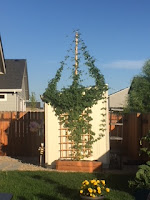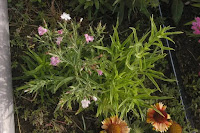Growing hops in the backyard is fun, easy, and rewarding. Hops can be grown in any moderate
climate with proper care. Hop vines called bines grow from a rhizome. Within a
few weeks of planting, noticeable growth happens. Several hop shoots start
peeking out of

the ground. Growth can be vigorous, bines growing up to two feet per week until mid-summer when the growth slows, and the plant enters the flowering stage. Hop bines can reach upward of 20 feet in height.
Hops were first introduced into Massachusetts from Europe in
1629. Commercial hop yards in the United States were reported to have been
established in New York in the early 1800s. Commercial hops production was
pushed westward during the 1920s by plant diseases encountered in the east,
primarily downy mildew. Modern hops production is currently in the western
United States in Oregon, Washington, and Idaho—areas less conducive to plant
diseases of the humid east.
Selecting Hops:
There are two basic groups and more than 100 varieties of
hops plants. Hops can grow in most moderate climates, but they do best in zones
5 through 9.
Bittering hops have high levels of specific acids that
produce bitterness in beer.
Aroma hops have a lower content of bittering acids and a more
balanced essential oil that produces pleasant aroma and flavor properties to
beer.
Warning: Hops cones can be toxic to dogs. Do not allow
your dog to eat the cones, either fresh or dried.
Planting and
Caring for Your Hops:
Hop plants
begin as rhizomes that require well-drained soil with a pH of 6 or 7 and long
periods of full sun exposure. In early spring, plant the rhizome about two
inches deep with buds pointed up.
Frequent shallow
watering will help establish a healthy root system. After the roots are
established, less frequent, deep watering helps increase root growth and
drought tolerance. Water directly at the base of the plant, wetness on the
leaves will encourage disease
formation.
Hop bines are
heavy feeders and will need a supplemental feed of compost, manure, or
fertilizer to remain strong.
Train your
plants to grow on a trellis system. The training process helps the bines stay
healthy and strong. Use twine to train the bines to the trellis. Select only vigorous
bines to train and prune away the less vigorous bines.
If the texture
is papery, and the cones is between one to two inches, the cone is ready to
pick. Inside the cone are small, yellow particles, called lupulin, that give
beer its flavor and aroma. Over the next few weeks the cones will mature at
different times. To avoid losing the lupulin use scissors or pruning shears.
Note: Hop
plants can cause skin irritation, so wearing gloves and long sleeves will help
to prevent any skin irritation.
Your cones are
ready for brewing when the central stems are brittle and lupulin powder falls
out easily. You can use the cones right away for brewing or stored in a sealed
container in
the freezer for later use.- Spread the hops out in the sunshine in a single layer protecting from wildlife.
- Dry hops in the oven, set the temperature at 140 degrees and leave the oven door slight open to allow moisture to escape.
- Electric food dehydrator at its lowest setting 90 to 100 degrees
After Harvest
Cut back bines
to about three feet. After first heavy frost, cut the remaining bines at the
soil surface and apply several inches of mulch over the grown plant.

























